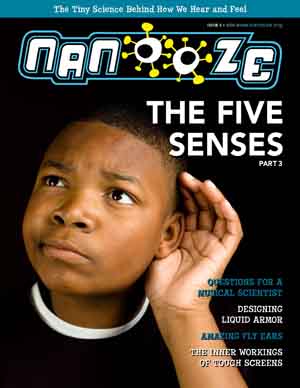The last issue in our three part series dedicated to the Five Senses. Issue #5 explores Hearing and Touch.
Most of the time we almost forget about them but there are five of them—smell, sight, hearing, taste and touch. A stinky sock, pizza, Red Hot Chili Peppers (the sound or the taste?), a bee sting (ouch). We get a stuffed nose and then we can’t taste much of anything. These are our five senses. How do they work? And what does this have to do with science? Lots.
We have lots of different kinds of cells in our body. Some of these cells help with our different senses and each sense involves a special kind of cell. Cells inside our eyes detect photons of light, while tiny, delicate parts of our ears sense the different vibrations of sound waves. All those cells are hooked up to our central nervous system, which relays the signals triggered by those special cells to our brain where they’re processed into a response. It may sound simple—touch an ice cube and your brain tells you “it’s cold”—but it involves a lot of specialized cells and a complex transfer system to transmit signals to the brain. Then once the signal arrives, your brain needs to figure out what’s going on and give you the right picture, sound, smell, taste or feeling. And it all happens at lightning speed!
Scientists study our five senses to learn more about how they work and are finding out that they are pretty complicated. Nanotechnology is helping us figure out what’s really happening in the tiniest parts of our bodies and can help us develop new tools that can sense like we do.
Download, view, and print Issue #5 as normal PDF
View Issue #5 as electronic book (flippable pages)
As always, you may request free classroom packs of any of the available issue of Nanooze (free to US public and private schools as well as various university and museum programs).
In this issue:
- Listen up
- The power of touch
- Hearing like a fly
- Liquid armor
- An interview with Catherine Oertel, a scientist and musician! What does nanotechnology have to do with old pipe organs?
- How “touch screens” work

